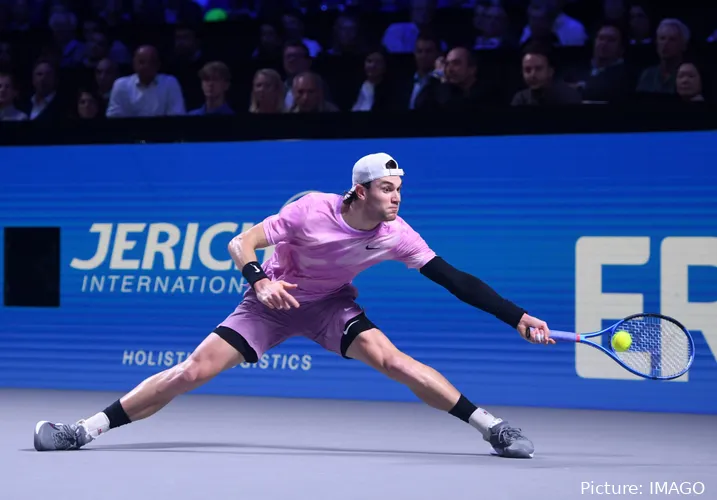
Following a breakthrough performance at the Vienna Open, British tennis star Jack Draper has climbed into the top 15 of the ATP rankings, and his trajectory only appears to be rising. After struggling with injuries for several years, Draper’s resurgence has been marked by remarkable form and resilience, prompting many to wonder just how far he can go. One notable figure weighing in on Draper’s potential is renowned tennis coach Patrick Mouratoglou, who has worked with Draper during the Ultimate Tennis Showdown (UTS) and has closely followed his progress. Mouratoglou sees Draper as a player with top-tier potential and the skillset to contend with the world’s best, provided he can avoid further injury setbacks.
In an interview with Sky Sports, Mouratoglou reflected on Draper’s journey, particularly highlighting the improvements he’s made over the past year. “I think he’s a great player. Last year when he won Ultimate Tennis Showdown [UTS], I think he played incredible tennis the whole three days,” Mouratoglou shared, alluding to Draper’s breakout performance at the UTS event. He observed that Draper has developed a more mature approach to his game, evident in his strategy, consistency, and ability to adapt under pressure. “I feel that now he’s much more mature in terms of his game, his game plan, his game style. Everything looks much more mature. And when you see him win in Vienna, you don’t feel he plays out of his mind. It’s his level. So, I think he improved a lot this year.”
However, Mouratoglou did acknowledge that Draper’s primary challenge will be staying injury-free. At only 22, Draper has already endured a string of injuries that have hampered his progress, making it crucial for him to focus on maintaining his physical fitness as he aims for the sport’s upper echelons. “I think the big challenge for him now is to stay injury-free because he’s been injured a lot for someone so young,” Mouratoglou said. “If he manages to stay injury-free, then I think he’s definitely a top-10 player and a player that has huge weapons and potentially has no limits.”
The improvements in Draper’s game have not gone unnoticed. Mouratoglou, who has firsthand experience coaching him at UTS, pointed to specific areas in Draper’s game that have advanced notably over the past year, including his backhand and his overall court discipline. “I feel that his backhand is much better,” Mouratoglou remarked. “Before, his backhand was not hurting the opponent much. I saw him play in Vienna, and I thought he’s taking the ball much earlier with the backhand, and he can hit the ball full, taking the ball early.” This new aggressiveness in his backhand has added a layer of depth to Draper’s game, giving him an effective weapon to disrupt his opponents.
Additionally, Mouratoglou praised Draper’s development in creating and executing a clear game plan, which he believes is a crucial improvement. “His game plan, the way he should play, his style is very, very clear now, which was not that obvious before,” he said. “He’s very solid and he’s very disciplined in what he’s doing. But I think that’s a major improvement he’s made this year.” This newfound clarity and discipline on the court have provided Draper with a solid foundation, allowing him to maintain composure and stick to his strategy even during high-pressure moments.
As Draper’s success in Vienna has sparked broader conversations about the emerging generation of tennis talent, Mouratoglou believes that Draper, along with other rising players, will be inspired by the ascension of young stars like Carlos Alcaraz and Jannik Sinner, who have already made their mark at the top of the ATP rankings. “I think there is a lot of competition at the moment. You have two guys who are way above the others, Sinner and Alcaraz. But I think there is also a new generation coming up with a lot of guys that have big potential. Jack is one of them,” Mouratoglou commented, emphasizing how players like Draper, who are not far off in age from Alcaraz and Sinner, might feel encouraged by their success. “He really believes in himself, which I think is great.”
Mouratoglou also drew an interesting comparison between Draper’s generation and the generation that rose under the shadow of tennis legends Rafael Nadal, Roger Federer, and Novak Djokovic. “We’ve been used to this generation of Rafa [Nadal], Roger [Federer], Novak [Djokovic]. The young generations that came up never thought they could make it because those three guys, in their mind, were unbeatable,” he noted. But with Alcaraz and Sinner establishing themselves at the top while still in their early 20s, players like Draper see a more accessible pathway to the top of the rankings. “I feel that Alcaraz and Sinner are young like them, so they think, ‘why not us?’”
In a broader perspective, Mouratoglou sees Draper as part of a promising new generation that could reshape the sport’s competitive landscape, echoing his optimism for a “big, big generation” of players capable of making it to the top. Despite the challenges ahead, including staying injury-free and building on his recent successes, Draper’s recent form and steady climb in the rankings underscore his potential. With a clear game plan, a renewed mental focus, and improved shot-making abilities, he has laid the groundwork for an exciting future.
As he continues his upward journey, Jack Draper embodies the spirit of a new generation that’s ready to rise to the occasion. His success at the Vienna Open not only signals his arrival among the sport’s elite but also sets the stage for an ambitious career. Mouratoglou’s remarks serve as both a testament to Draper’s hard work and a reminder of the high stakes in his path forward. If Draper can stay healthy and keep refining his game, he may indeed have what it takes to become one of the next big names in tennis.
Leave a Reply